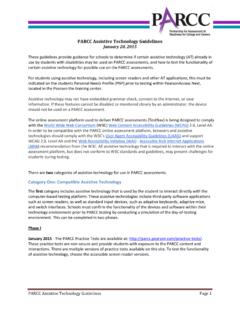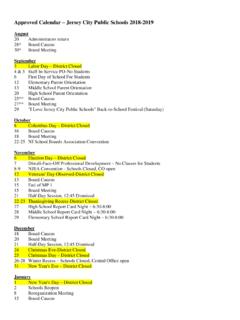Transcription of Accommodations/Modifications/Interventions
1 Accommodations/Modifications/Interventio ns Accommodations, modification and interventions accommodation : An accommodation can be made for any student, not just students with a 504 plan or an IEP. An accommodation does not alter what the student is expected to learn. An accommodation makes learning accessible to the student and allows the student to demonstrate what they know. Accommodations are alterations in the way tasks are presented that allow children with a disability to complete the same assignments as other children. Accommodations do not alter the content of assignments, give students an unfair advantage or in the case of assessments, change what a test measures. They do make it possible for students with LD to show what they know without being impeded by their disability. Accommodations are basically physical or environmental changes, generally referred to as good teaching strategies. Extended time, frequent breaks, varying of activities Change in classroom, preferential seating, physical arrangement of the room, reducing/minimizing distractions, cooling off period Emphasizes varied teaching approaches (visual, auditory, multi-sensory), individual or small group, demonstrating/modeling, visual cues, use of manipulatives, pre-teaching, graphic organizers Highlighting material, note taking assistance, notes provided by teacher, calculator, computer, word processor, Braille, and/or large print Directions given in small, sequential steps, copying from book Positive reinforcement, concrete reinforcement, checking for understanding, study guides, before/after school tutoring Reading test verbatim, shortening length of test, test format changed (multiple choice vs.)
2 Fill in the blank) Allow for verbal responses Should accommodations have an impact on how assignments are graded? School assignments and tests completed with accommodations should be graded the same way as those completed without accommodations. After all, accommodations are meant to level the playing field, provide equal and ready access to the task at hand, and not meant to provide an undue advantage to the user. What if accommodations don t seem to be helping? Selecting and monitoring the effectiveness of accommodations should be an ongoing process, and changes (with involvement of students, parents and educators) should be made as often as needed. The key is to be sure that chosen accommodations address students specific areas of need and facilitate the demonstration of skill and knowledge. modification Modifications are generally made for students with significant cognitive or physical disabilities. A modification does alter content knowledge expectations as well as assessment administration practices.
3 A modification is a change in the course of study, standards, test preparation, location, timing, scheduling, expectations, student response and/or other attribute which provide access for a student with a disability to participate in a course, standard or test. It does fundamentally alter or lower the standard or expectation of the course, standard or test. Modifications are used in the classroom to meet the needs of every child s strength. Modifications involve lowering the level of materials presented. Presentation of curriculum is modified using a specialized curriculum which is written at a lower level of understanding. Materials are adapted; texts are simplified by modifying the content areas simplifying vocabulary, concepts and principles. Grading is subject to different standards than general education, such as based on IEP goals. Assignments are changed using lower level reading levels, worksheets and simplified vocabulary. Testing Adaptations are used, such as lowering the reading level of the test.
4 Accommodations vs. Modifications Accommodations level the playing field while Modifications change the field you re playing on.. Decisions must be based on the child s unique and individualized need, not on what we do for all kids with a particular classification. The use of accommodations or modifications should enable the child to demonstrate progress. Individual Education Plans should offer children equal opportunity for success. Accommodations for Students with Learning Disabilities By: National Center for Learning Disabilities (2006) interventions : An intervention is a specific skill-building strategy implemented and monitored to improve a targeted skill ( what is actually known) and achieve adequate progress in a specific area (academic or behavioral). This often involves a changing instruction or providing additional instruction to a student in the area of learning or behavior difficulty. Academic or behavior interventions are strategies or techniques applied to instruction in order to teach a new skill, build a fluency skill, or encourage the application of existing skills to a new situation.
5 interventions require a targeted assessment, planning, and date collection. interventions should be evidence based and monitored regularly to determine growth and to inform instruction. interventions differ from accommodations and modifications in that they teach new skills to help students overcome specific deficits or maladaptive response patterns. interventions require a targeted assessment, planning, and data collection (ideally including baseline data) to be effective. Consideration is given to the nature of the problem ( skill deficit versus performance deficit). interventions focus on the needs of the individual student. Ted Gennerman, Accommodations vs. interventions vs. Modifications Accommodations interventions Modifications Accommodate is defined as to make fit.
6 It is similar to adaptation. Accommodations and adaptations are used to describe how students are included in classroom instruction. Changes to the classroom structure, both organizationally and instructionally that allows a student to participate. An intervention is defined as to come between. Doctors use medications for intervention. Medications are used to intervene with a fever to change the body temperature. Teachers use strategies to change a student s learning outcomes. Modify is defined as to alter; to make different in form .. to change to less extreme Most often associated with IDEA. Students receiving special education services. Teachers use modifications of grade level standards, strategies, curriculum and assessments to create a learning environment for a specific student Using grade level curriculum standards via a different path think differentiated. Adaptations to the regular curriculum to make it possible for the child to be successful at benchmark Additions to the curriculum to designed to help a student make progress toward benchmarks.
7 Change in curriculum standards. Change in core program; use of a parallel curriculum that does not include all grade level standards Designates different benchmarks. Levels the Playing Field Ensures the Playing Field Creates the Playing Field Changes something about the child's environment or services provided. A change that helps a student overcome or work around a learning problem. Teaches the student a new skill. Teaches the student a strategy to use when applying a skill. A change in what is being taught to or expected from the student. Accommodations interventions Modifications Preferential seating Mini-lessons of skill deficits Student is involved in the same theme/unit but is provided different tasks/expectations Shortened assignments Targeted instruction based on progress monitoring Individualized materials are provided for student Peer-tutoring Additional instruction to students in small groups or individually Eliminate specific standards Moving obstacles in a classroom so that a student with a wheelchair could navigate the classroom.
8 Increase task structure ( , directions, rationale, checks for understanding, feedback) Create individualized benchmarks Classroom level: seating arrangements, note talking, outline/study guides, tape recorders, etc. Increase opportunities to engage in active academic responding ( , writing, reading aloud, answering questions in class, etc.) Repeat/confirm directions Multi-sensory techniques Additional time to complete assignment Familiar Reading activities for fluency Audio tape Speed sorts of ABCs, sight words Reduce the number of items per page or line Build automaticity with known information, letters, words, phonetic patterns Provide a designated reader Follow up reading with story frame activities: story summary, important ides or plot, setting, character analysis and comparison Present instructions orally Model metacognition Allow for verbal responses Utilize prereading strategies and activities: previews, anticipatory guides, and semantic mapping Allow for answers to be dictated Use reciprocal teaching to promote comprehension and comprehension monitoring: predicting, question generating, summarizing and clarifying Note.
9 This is NOT an exhaustive Accommodations interventions Modifications Permit response provided via computer or electronic device Underline word and phrase clues that lead to making an inference Allow frequent breaks Echo reading: the student imitates the teacher s oral rendition, one sentence or phrase at a time Extend allotted time for tests Provide a place with minimal distractions Administer tests in several sessions Administer tests at a specific time of day Provide special test preparation








